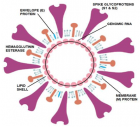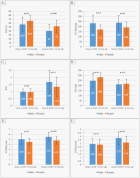Abstract
Research Article
Save the radial: go distally
Rima Chaddad, Hussein Rabah, Batoul Awada* and Malek Hmadeh
Published: 07 April, 2022 | Volume 7 - Issue 1 | Pages: 026-029
Coronary artery disease is the leading cause of death worldwide.
Percutaneous coronary intervention (PCI) is one of the most widely performed medical procedures used to save lives, currently over 3 million annually worldwide.
The femoral artery has been the preferred vascular access site.
However, radial access is gaining extensive popularity due to the benefits of earlier ambulation, fewer access site complications, and decreased rates of bleeding.
Improvements in technology and understanding of the anatomic features of the vascular system have led to new insights into coronary angiography procedures.
Distal radial access, which was first used in 2017, shows a higher success rate and fewer complications than previous sites; therefore, it might be the future for cardiovascular intervention.
For this purpose, we conducted this prospective study at Beirut Cardiac Institute (BCI) comparing the two arms: radial vs. distal radial artery techniques through the anatomical snuffbox, in terms of patient’s length of stay, complication rate, and success rate of each procedure.
Read Full Article HTML DOI: 10.29328/journal.jccm.1001128 Cite this Article Read Full Article PDF
References
- Helfrich CD, Tsai TT, Rao SV, Lemon JM, Eagenis EC, et al. Perceptions of advantages and barriers to radial access percutaneous coronary intervention in VA cardiac catheterization laboratories. Cardiovasc Revasc 2014; 15: 329-333. PubMed: https://pubmed.ncbi.nlm.nih.gov/25282521/
- Amoroso G. Transradial approach for percutaneous coronary interventions: the future is now. Interventional Cardiol. 2013; 5: 279-288.
- Archbold RA, Robinson NM, Schilling RJ. Radial artery access for coronary angiography and percutaneous coronary intervention. BMJ. 2004; 329: 443–446. PubMed: https://pubmed.ncbi.nlm.nih.gov/15321904/
- Kiemeneij F, Laarman GJ. Percutaneous transradial artery approach for coronary stent implantation. Catheter Cardiovasc Diagn. 1993; 30: 173–178. PubMed: https://pubmed.ncbi.nlm.nih.gov/8221875/
- Valgimigli M, Gagnor A, Calabró P, Frigoli E, Leonardi S, et al. Radial versus femoral accessin patients with acute coronary syndromes undergoing invasive management: a randomised multi-centre trial. Lancet. 2015; 385: 2465–2476. PubMed: https://pubmed.ncbi.nlm.nih.gov/25791214/
- Lee CW, Cho SC. The Transradial Approach for Coronary Intervention: More Comfort, Better Outcome. Korean Circ J. 2018; 48: 728–730. PubMed: https://www.ncbi.nlm.nih.gov/pmc/articles/PMC6072665/
- Nairoukh Z, Jahangir S, Adjepong D, Malik Distal Radial Artery Access: The Future of Cardiovascular Intervention. Cureus.2020; 12: e7201. PubMed: https://pubmed.ncbi.nlm.nih.gov/32269880/
- Sgueglia GA, Di Giorgio A, Gaspardone A, Babunashvili A. Anatomic Basis and Physiological Rationale of Distal Radial Artery Access for Percutaneous Coronary and Endovascular Procedures. JACC: Cardiovasc Interv. 2018; 11: 2113–2119. PubMed: https://pubmed.ncbi.nlm.nih.gov/30336816/
- Corcos T. Distal radial access for coronary angiography and percutaneous coronary intervention: a state-of-the-art review. Catheter Cardiovasc Interv. 2019; 93: 639-644. PubMed: https://pubmed.ncbi.nlm.nih.gov/30536709/
- Sgueglia GA, Di Giorgio A, Gaspardone A, Babunashvili A. Anatomic basis and physiological rationale of distal radial artery access for percutaneous coronary and endovascular procedures. JACC Cardiovasc Interv. 2018; 11: 2113-2119. PubMed: https://pubmed.ncbi.nlm.nih.gov/30336816/
- Kaledin AL, Kochanov IN, Podmetin PS, Seletsky SS, Ardeev VN. Distal radial artery in endovascular interventions. ARYA Atheroscler. 2018; 14: 95-100.
- Lee JW, Park SW, Son JW, Ahn SG, Lee SH. Real-world experience of the left distal transradial approach for coronary angiography and percutaneous coronary intervention: a prospective observational study (LeDRA). 2018; 14: e995-e1003. PubMed: https://pubmed.ncbi.nlm.nih.gov/30222122/
- Ziakas A, Koutouzis M, Didagelos M, Tsiafoutis I, Kouparanis A, et al. Right arm distal transradial (snuffbox) access for coronary catheterization: Initial experience. Hellenic J Cardiol. 2020; 61: 106-109. PubMed: https://pubmed.ncbi.nlm.nih.gov/30389385/
- Aqel R, Alzughayyar T, Misk R. Radial: time to go distal. Cardiol Cardiovasc Med 2019; 3: 432-437.
- Hammami R, Zouari F, Ben Abdessalem MA, Sassi A, Ellouze T, et al. Distal radial approach versus conventional radial approach: a comparative study of feasibility and safety. Libyan J Med. 2021; 16: 1830600. PubMed: https://pubmed.ncbi.nlm.nih.gov/33147107/
- Asharaf T, Panhwar Z, Habib S, Memon MA, Shamsi F, et al. Size of radial and ulnar artery in local population. J Pak Med Assoc. 2010; 60: 817-819. PubMed: https://pubmed.ncbi.nlm.nih.gov/21381609/
Figures:

Figure 1
Similar Articles
-
Left Atrial Remodeling is Associated with Left Ventricular Remodeling in Patients with Reperfused Acute Myocardial InfarctionChristodoulos E. Papadopoulos*,Dimitrios G. Zioutas,Panagiotis Charalambidis,Aristi Boulbou,Konstantinos Triantafyllou,Konstantinos Baltoumas,Haralambos I. Karvounis,Vassilios Vassilikos. Left Atrial Remodeling is Associated with Left Ventricular Remodeling in Patients with Reperfused Acute Myocardial Infarction. . 2016 doi: 10.29328/journal.jccm.1001001; 1: 001-008
-
Mid-Ventricular Ballooning in Atherosclerotic and Non-Atherosclerotic Abnormalities of the Left Anterior Descending Coronary ArteryStefan Peters*. Mid-Ventricular Ballooning in Atherosclerotic and Non-Atherosclerotic Abnormalities of the Left Anterior Descending Coronary Artery. . 2016 doi: 10.29328/journal.jccm.1001002; 1:
-
Concentration Polarization of Ox-LDL and Its Effect on Cell Proliferation and Apoptosis in Human Endothelial CellsShijie Liu*,Jawahar L Mehta,Yubo Fan,Xiaoyan Deng,Zufeng Ding*. Concentration Polarization of Ox-LDL and Its Effect on Cell Proliferation and Apoptosis in Human Endothelial Cells. . 2016 doi: 10.29328/journal.jccm.1001003; 1:
-
Intermittent Left Bundle Branch Block: What is the Mechanism?Hussam Ali*,Riccardo Cappato. Intermittent Left Bundle Branch Block: What is the Mechanism?. . 2017 doi: 10.29328/journal.jccm.1001004; 2:
-
Congenital Quadricuspid Aortic Valve, a Rare Cause of Aortic Insufficiency in Adults: Case ReportCyrus Kocherla*,Kalgi Modi. Congenital Quadricuspid Aortic Valve, a Rare Cause of Aortic Insufficiency in Adults: Case Report. . 2017 doi: 10.29328/journal.jccm.1001005; 2: 003-007
-
Short and Medium-Term Evaluation of Patients in Coronary Post-Angioplasty: Préliminary results at the Cardiology Department of the Hospital University Aristide Le Dantec of Dakar (Senegal): Study on 38 CasesDioum M*,Aw F,Masmoudi K,Gaye ND,Sarr SA,Ndao SCT, Mingou J,Ngaidé AA,Diack B,Bodian M,Ndiaye MB,Diao M,Ba SA. Short and Medium-Term Evaluation of Patients in Coronary Post-Angioplasty: Préliminary results at the Cardiology Department of the Hospital University Aristide Le Dantec of Dakar (Senegal): Study on 38 Cases. . 2017 doi: 10.29328/journal.jccm.1001006; 2: 008-012
-
Indications and Results of Coronarography in Senegalese Diabetic Patients: About 45 CasesNdao SCT*,Gaye ND,Dioum M,Ngaide AA,Mingou JS,Ndiaye MB, Diao M,Ba SA. Indications and Results of Coronarography in Senegalese Diabetic Patients: About 45 Cases. . 2017 doi: 10.29328/journal.jccm.1001007; 2: 013-019
-
Procedure utilization, latency and mortality: Weekend versus Weekday admission for Myocardial InfarctionNader Makki,David M Kline,Arun Kanmanthareddy,Hansie Mathelier,Satya Shreenivas,Scott M Lilly*. Procedure utilization, latency and mortality: Weekend versus Weekday admission for Myocardial Infarction. . 2017 doi: 10.29328/journal.jccm.1001008; 2: 020-025
-
Spontaneous rupture of a giant Coronary Artery Aneurysm after acute Myocardial InfarctionOğuzhan Çelik,Mucahit Yetim,Tolga Doğan,Lütfü Bekar,Macit Kalçık*,Yusuf Karavelioğlu. Spontaneous rupture of a giant Coronary Artery Aneurysm after acute Myocardial Infarction. . 2017 doi: 10.29328/journal.jccm.1001009; 2: 026-028
-
Thrombolysis, the only Optimally Rapid Reperfusion TreatmentVictor Gurewich*. Thrombolysis, the only Optimally Rapid Reperfusion Treatment. . 2017 doi: 10.29328/journal.jccm.1001010; 2: 029-034
Recently Viewed
-
Acyclovir Induced Acute Kidney Injury: A Case ReportZiauddin Mohammed*, Mariya Zoha Muskan, Megha Mohan Narayanan. Acyclovir Induced Acute Kidney Injury: A Case Report. Arch Pharm Pharma Sci. 2024: doi: 10.29328/journal.apps.1001048; 8: 001-002
-
Evaluation of the Anti-inflammatory Activity of Equisetum arvense and Baccharis trimera FractionsCarolina Ferreira Vaz, Alan Fernandes Mariano, Júlia Amanda Rodrigues Fracasso, Marcus Vinicius Vieitas Ramos, Lucineia dos Santos, Herbert Júnior Dias*. Evaluation of the Anti-inflammatory Activity of Equisetum arvense and Baccharis trimera Fractions. Arch Pharm Pharma Sci. 2024: doi: 10.29328/journal.apps.1001049; 8: 003-008
-
The Cortisol Connection: Weight Gain and Stress HormonesBalvinder Singh, Neelesh Kumar Maurya*. The Cortisol Connection: Weight Gain and Stress Hormones. Arch Pharm Pharma Sci. 2024: doi: 10.29328/journal.apps.1001050; 8: 009-013
-
Correlation of Inappropriate use of Ceftriaxone and Bacterial Resistance in the Hospital Environment: Integrative ReviewLarissa Furtado Abrantes, Joyce Lima de Sousa, Joel Messias Soares Ramos, Rafael Rodrigues Leite, Sávio Benvindo Ferreira*. Correlation of Inappropriate use of Ceftriaxone and Bacterial Resistance in the Hospital Environment: Integrative Review. Arch Pharm Pharma Sci. 2024: doi: 10.29328/journal.apps.1001051; 8: 014-020
-
Next Generation Tools in mRNA Purification: The Role of Continuous Raman Spectroscopy Testing with Pretreatment of the SampleLuisetto M*, Nili B Ahmadabadi, Khaled Edbey, Oleg Yurevich Latyshev. Next Generation Tools in mRNA Purification: The Role of Continuous Raman Spectroscopy Testing with Pretreatment of the Sample. Arch Pharm Pharma Sci. 2024: doi: 10.29328/journal.apps.1001052; 8: 021-023
Most Viewed
-
Evaluation of Biostimulants Based on Recovered Protein Hydrolysates from Animal By-products as Plant Growth EnhancersH Pérez-Aguilar*, M Lacruz-Asaro, F Arán-Ais. Evaluation of Biostimulants Based on Recovered Protein Hydrolysates from Animal By-products as Plant Growth Enhancers. J Plant Sci Phytopathol. 2023 doi: 10.29328/journal.jpsp.1001104; 7: 042-047
-
Sinonasal Myxoma Extending into the Orbit in a 4-Year Old: A Case PresentationJulian A Purrinos*, Ramzi Younis. Sinonasal Myxoma Extending into the Orbit in a 4-Year Old: A Case Presentation. Arch Case Rep. 2024 doi: 10.29328/journal.acr.1001099; 8: 075-077
-
Feasibility study of magnetic sensing for detecting single-neuron action potentialsDenis Tonini,Kai Wu,Renata Saha,Jian-Ping Wang*. Feasibility study of magnetic sensing for detecting single-neuron action potentials. Ann Biomed Sci Eng. 2022 doi: 10.29328/journal.abse.1001018; 6: 019-029
-
Pediatric Dysgerminoma: Unveiling a Rare Ovarian TumorFaten Limaiem*, Khalil Saffar, Ahmed Halouani. Pediatric Dysgerminoma: Unveiling a Rare Ovarian Tumor. Arch Case Rep. 2024 doi: 10.29328/journal.acr.1001087; 8: 010-013
-
Physical activity can change the physiological and psychological circumstances during COVID-19 pandemic: A narrative reviewKhashayar Maroufi*. Physical activity can change the physiological and psychological circumstances during COVID-19 pandemic: A narrative review. J Sports Med Ther. 2021 doi: 10.29328/journal.jsmt.1001051; 6: 001-007

HSPI: We're glad you're here. Please click "create a new Query" if you are a new visitor to our website and need further information from us.
If you are already a member of our network and need to keep track of any developments regarding a question you have already submitted, click "take me to my Query."























































































































































